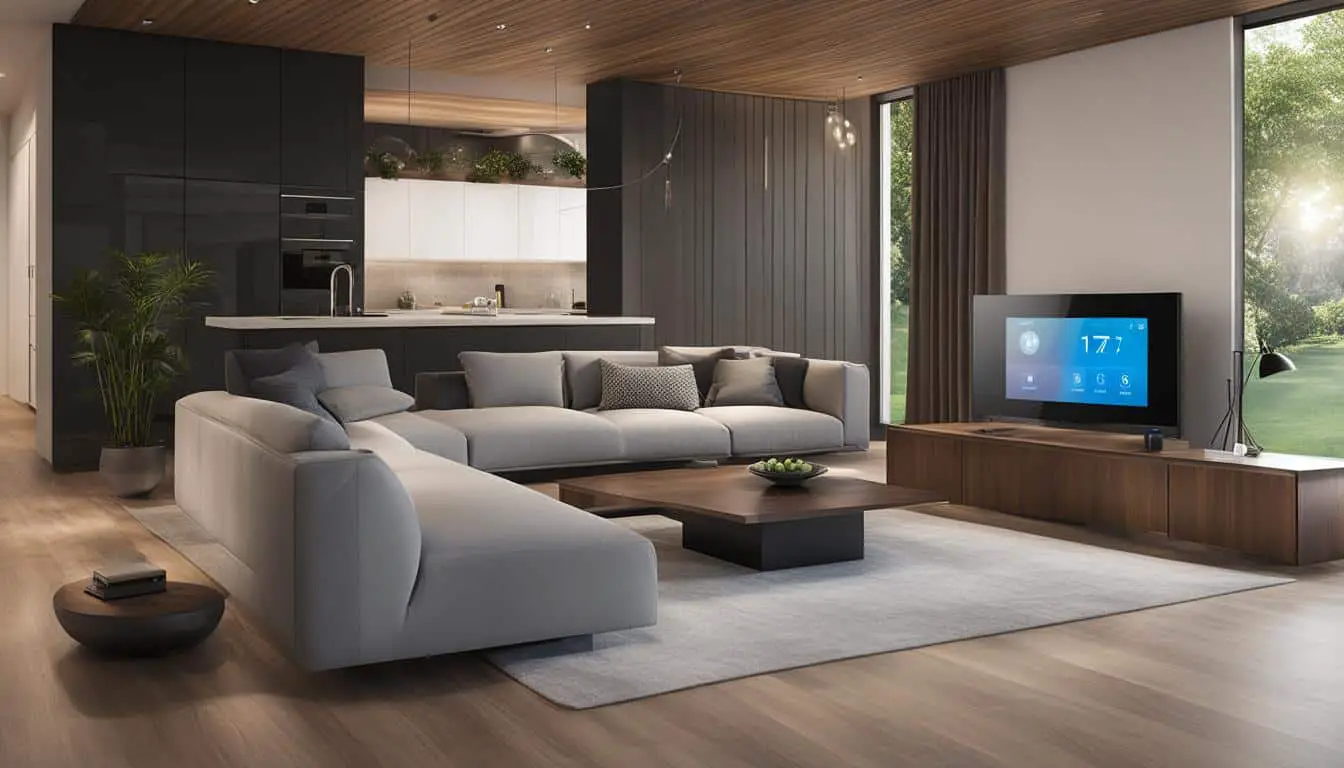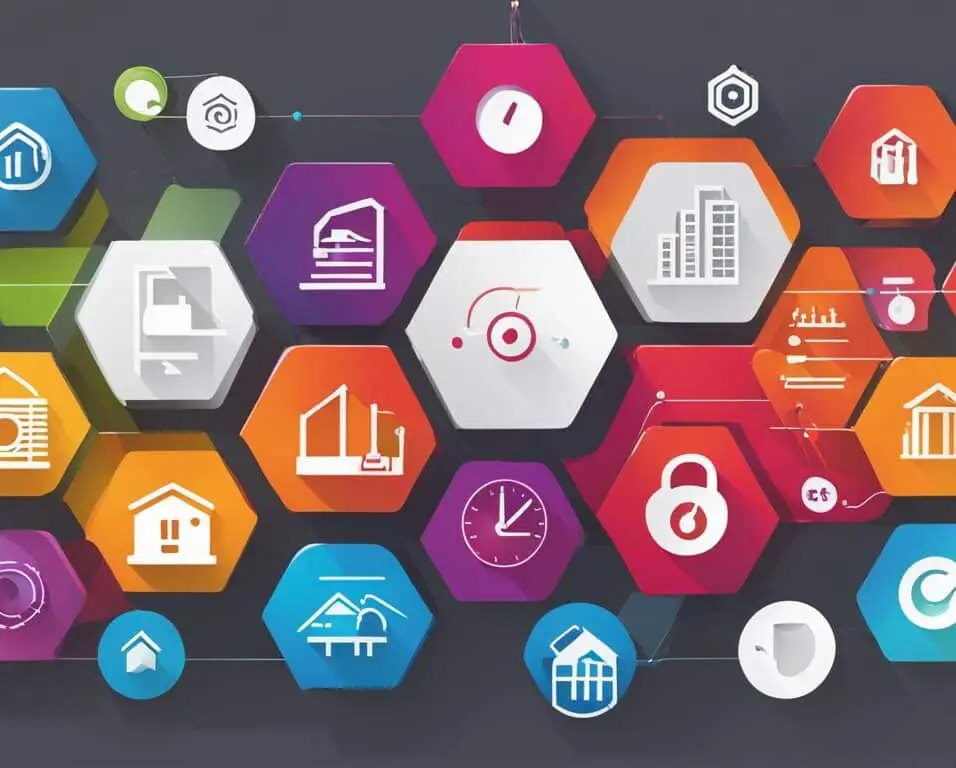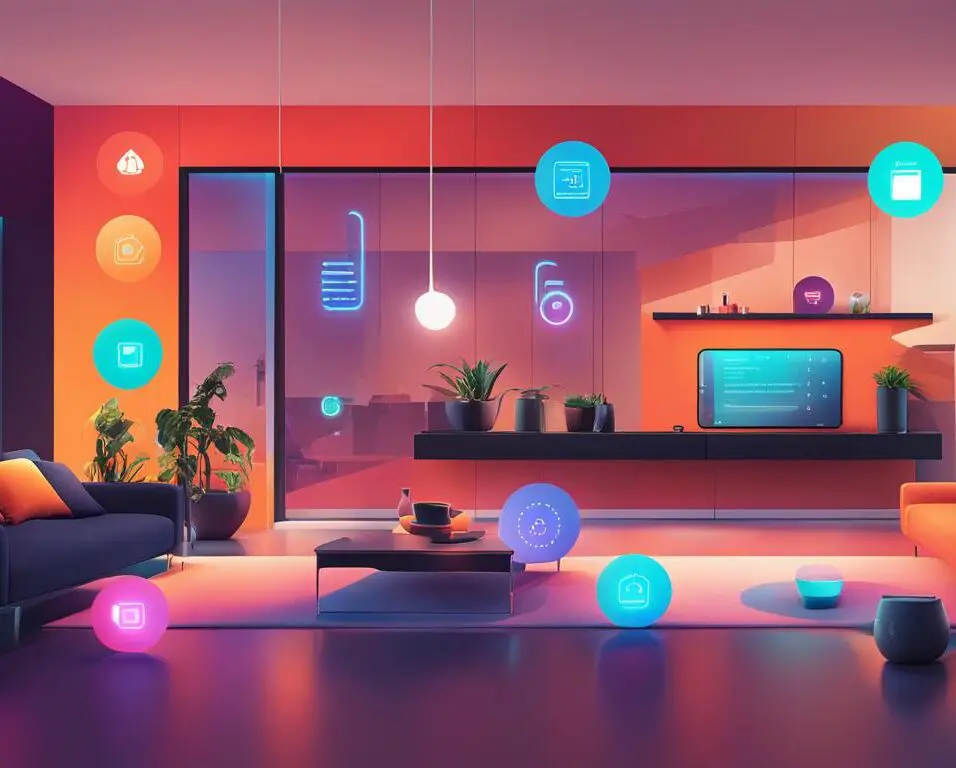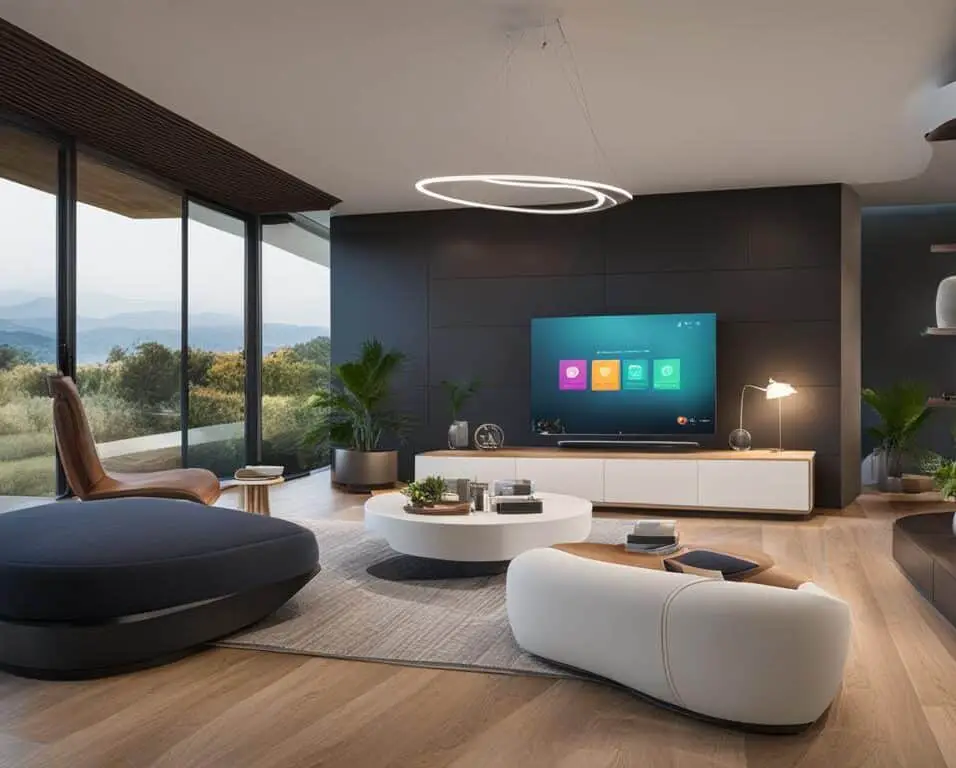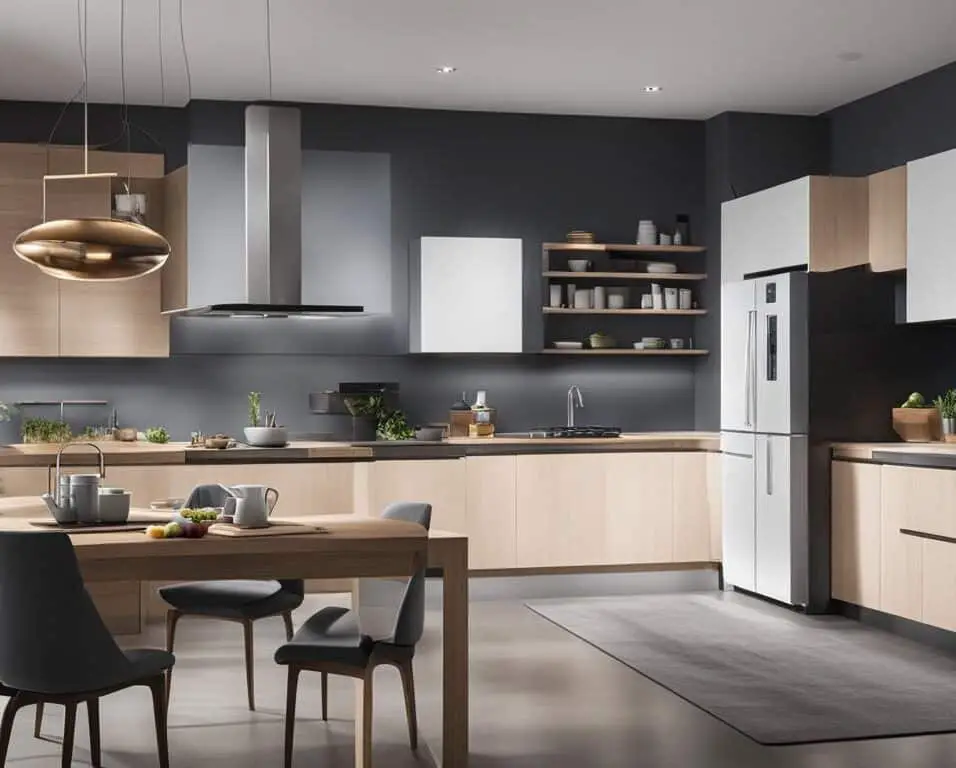IoT Solutions for Modern Home Automation
I am excited to introduce you to the world of IoT solutions for modern home automation. With the rapid advancement of technology, our homes are now equipped with innovative devices and systems that make our lives more convenient, secure, and personalized than ever before.
IoT, or the Internet of Things, has revolutionized the concept of home automation by integrating advanced technology into our everyday lives. From controlling lights, security systems, and climate settings to managing household appliances and entertainment devices, IoT-powered smart homes offer unparalleled convenience and efficiency.
One of the key aspects of IoT home automation is the utilization of big data analysis. By collecting and analyzing data from various sensors and devices, IoT systems optimize and personalize the user experience, providing customized solutions based on individual preferences and habits.
Artificial intelligence is another game-changer in the world of IoT-powered smart homes. These systems learn from residents’ habits and behavior patterns, enabling them to make intelligent decisions and perform tasks automatically, without the need for manual intervention.
To overcome the challenges of latency, network efficiency, and data security, IoT home automation systems leverage edge and fog computing. These technologies bring processing power closer to the data source, reducing response time and improving overall performance and security.
Computer vision is also a vital component of IoT home automation. By integrating cameras and image recognition algorithms, these systems can provide features like facial recognition for access control and fall detection for enhanced safety.
Voice recognition technology is yet another remarkable innovation in the realm of IoT home automation. With voice-activated devices like smart speakers, users can control their smart home devices using natural language commands, enjoying a hands-free and intuitive experience.
And finally, augmented and virtual reality applications are paving the way for a more immersive and interactive smart home experience. With AR/VR technology, users can visualize and control their smart home devices in a virtual environment, making the management of their homes even more intuitive and engaging.
Key Takeaways:
- IoT solutions have revolutionized modern home automation, enhancing convenience, security, and personalization.
- Big data analysis optimizes and personalizes the user experience in IoT home automation.
- Artificial intelligence learns from residents’ habits and behavior patterns, enabling intelligent automation in smart homes.
- Edge and fog computing reduce latency, improve efficiency, and enhance data security in IoT home automation systems.
- Computer vision provides features like facial recognition and fall detection for enhanced security and safety in smart homes.
The Current State of IoT Home Automation
IoT smart home device sales are expected to reach over $53 billion by 2022, indicating the growing popularity of home automation.
While the market for smart home systems is not new, IoT home automation solutions are becoming more accessible to a wider audience.
The adoption of IoT in smart homes has focused more on convenience, connectedness, and security rather than improving the quality of life. The potential improvement to the quality of life through IoT home automation has not been extensively discussed.
The integration of IoT devices in smart homes has the potential to transform domestic life, but there are concerns about privacy and the loss of traditional home values.
The resistance to widespread adoption of IoT smart home technology can be attributed to the lack of a cohesive interface and the proliferation of niche products without a clear purpose.
The Critical Tipping Point
“The critical tipping point for IoT smart homes, similar to the smartphone market, is the development of a superior home integration hub that simplifies device interaction.”
This hub would consolidate all smart devices in one centralized system, making it easier for users to control and manage their IoT devices.
The hub would address the concerns regarding the lack of interoperability between different IoT devices and offer a seamless user experience. With a superior home integration hub, IoT smart homes can reach their full potential in enhancing convenience, security, and overall quality of life.
Comparison of IoT Home Automation Solutions
| Category | Features | Benefits |
|---|---|---|
| Convenience |
|
|
| Security |
|
|
| Energy Efficiency |
|
|
The current state of IoT home automation offers convenience, security, and potential improvements in quality of life. However, overcoming challenges such as privacy concerns and lack of a cohesive interface is crucial for widespread adoption.
Developing a superior home integration hub that simplifies device interaction is the critical tipping point for IoT smart homes to unlock their full potential. With continued advancements, smart homes powered by IoT technology have the potential to transform the way we live and enhance our everyday experiences.
The Future of Smart Home Technology
A smart home system is a comprehensive integration of IoT devices, electronic interfaces, and communication networks that can be conveniently controlled using a connected app. This modern marvel brings automation, convenience, and security to homeowners, transforming ordinary houses into smart homes of the future.
At the heart of a smart home system lies the hub, which acts as a command center, connecting all the smart devices and facilitating their interaction. Through seamless integration, the hub allows homeowners to control and monitor their smart home devices from anywhere, at any time.

Enhanced Functionality with IoT Sensors
To further enhance the functionality of smart home automation systems, IoT sensors play a crucial role. These sensors include motion sensors, CO/fire sensors, and leak detection sensors, among others, and they add an extra layer of intelligence to the system.
Motion sensors detect movements in specific areas, improving home security and alerting homeowners of any potential intrusions. CO/fire sensors are designed to detect the presence of carbon monoxide, smoke, and other harmful pollutants, ensuring the safety of residents and monitoring air quality. Leak detection sensors, on the other hand, are strategically placed near plumbing pipes and water-related devices, immediately notifying homeowners of any water leaks or potential damage.
Smart Home Features for a Connected Lifestyle
IoT-powered smart home automation offers an array of popular features that bring convenience and control to homeowners. With remote lighting control, homeowners can easily adjust the brightness and color of their lights, creating the perfect ambiance for any occasion.
Automated window treatments enable homeowners to open and close blinds or curtains with a touch of a button, enhancing privacy and energy efficiency. Advanced security systems provide round-the-clock protection by integrating cameras, sensors, and alarms, giving homeowners peace of mind.
Remote climate management allows homeowners to control their heating and cooling systems from afar, ensuring optimal comfort and energy savings. Additionally, homeowners can seamlessly control and monitor their connected devices, such as appliances, entertainment systems, and healthcare devices, from the convenience of a single app.
The Benefits of Home Automation Systems
The adoption of IoT in home automation systems brings numerous benefits to homeowners. Firstly, it greatly enhances property protection, with the ability to monitor and control security measures from anywhere. Secondly, the efficient usage of energy through IoT-enabled devices leads to significant cost savings and a more sustainable lifestyle.
Furthermore, home automation systems offer flexibility for scalability and customization. Homeowners can easily expand and integrate new devices into their existing systems, tailoring their smart homes to their specific needs and preferences.
One of the most significant advantages of IoT home automation is the convenience it provides through remote access and control. Homeowners can adjust settings, monitor activities, and receive real-time notifications, all from the palm of their hand.
Prioritizing Security in IoT Home Automation
While IoT home automation presents numerous benefits, security remains a major concern. To protect user privacy and prevent unauthorized access or breaches, the industry must prioritize security measures.
Strong passwords, encryption, and two-factor authentication are essential safeguards against hacking attempts. Regular software bug fixes and updates also play a vital role in maintaining the integrity of smart home systems.
Overall, the future of smart home technology is bright. As the Internet of Things continues to evolve, we can expect further advancements in voice control, artificial intelligence integration, and an ever-expanding range of IoT-enabled devices. With a focus on security and user-friendly interfaces, smart home automation is set to revolutionize the way we live.
The Growing Market for Smart Home Systems
The smart home market is experiencing rapid growth, with the revenue projected to reach $222.90 billion by 2027. This represents a compound annual growth rate (CAGR) of 12.47% between 2022 and 2027. The increasing adoption of internet and mobile devices, coupled with the desire for enhanced quality of life and security, is driving the popularity of smart home systems.
Factors such as lower prices for IoT devices and higher disposable income have also contributed to the surge in smart home adoption. Additionally, aspirations for a sustainable lifestyle and energy efficiency are playing a key role in the increased demand for smart home management solutions.
Smart home systems consist of IoT devices, electronic interfaces, and communication networks that can be controlled through a connected mobile app. This integration allows users to automate various aspects of their homes, such as access control and security, climate control, lighting control, and more.
The versatility and scalability of smart home systems make them suitable for various needs and preferences. Users have the flexibility to easily integrate new devices and expand the functionality of their smart homes over time. Whether it’s managing home appliances or creating a fully connected entertainment and healthcare ecosystem, smart home systems offer a wide range of options.
A comprehensive overview of the smart home market is provided in the table below:
| Smart Home Devices | Market Segment | Projected Revenue |
|---|---|---|
| Access control and security devices | Security | $53.2 billion |
| Climate control systems | Energy management | $36.1 billion |
| Resource managers | Energy management | $19.3 billion |
| Lighting control solutions | Home automation | $16.7 billion |
| Home appliances | Home automation | $12.8 billion |
| Entertainment and healthcare devices | Entertainment and healthcare | $15.5 billion |
The rapidly growing smart home market presents a wealth of opportunities for individuals looking to enhance their living spaces with cutting-edge technology. With the ever-expanding range of smart home devices and the constant evolution of IoT technology, the future of home automation looks promising.
IoT Sensors for Enhanced Home Automation
Various IoT sensors are utilized in smart home automation to ensure multifunctionality and enhance user experience.
Motion sensors, such as those from brands like Ring and Philips Hue, are used for detecting movements in a specific area and improving home security. They can trigger lights, cameras, and notifications to create a sense of safety and deter intruders.
CO/fire sensors, like the ones offered by Nest and First Alert, detect carbon monoxide, smoke, and other pollutants in the air, enhancing safety and monitoring air quality. These sensors can quickly alert homeowners to potential dangers and help prevent accidents.
Leak detection sensors, such as those from companies like Flo by Moen and Honeywell, are placed near plumbing pipes and water-related devices to detect and notify users of any water leakage or potential damage. These sensors are crucial in preventing costly water damage and giving homeowners peace of mind.
Other popular IoT sensors utilized in smart home automation include temperature sensors, air composition sensors, sound sensors, humidity sensors, pressure sensors, ultrasonic sensors, and light level sensors. These sensors enable smart home systems to respond to specific environmental conditions and automate control over various appliances and devices.
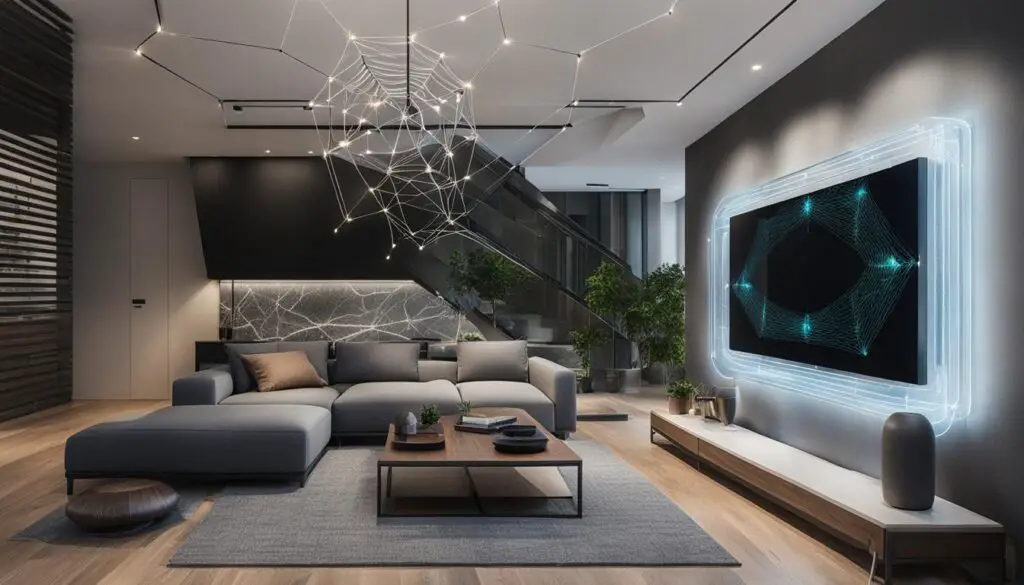
| Sensor Type | Function | Brands |
|---|---|---|
| Motion Sensors | Detect movements and improve home security | Ring, Philips Hue |
| CO/Fire Sensors | Detect carbon monoxide, smoke, and pollutants | Nest, First Alert |
| Leak Detection Sensors | Detect water leakage and potential damage | Flo by Moen, Honeywell |
| Other IoT Sensors | Monitor temperature, air composition, sound, humidity, pressure, ultrasonic levels, and light | Variety of brands |
Conclusion
The integration of IoT devices in smart homes has revolutionized home automation, offering a multitude of benefits for homeowners. With IoT smart home solutions, residents can enjoy enhanced convenience, security, and energy efficiency in their daily lives. Through the growing adoption of internet and mobile devices, coupled with the desire for improved quality of life and security, the market for smart home systems is expanding rapidly.
Smart home management solutions provide a wide range of features that contribute to a more comfortable and connected living environment. Homeowners can remotely control lighting, manage climate settings, and enjoy advanced security systems. Moreover, the integration of various IoT devices allows for seamless interconnectivity between devices for a holistic home automation experience.
The future of smart home technology lies in the development of cohesive home integration hubs, simplifying device interaction and creating an intuitive user experience. These hubs will serve as command centers, seamlessly connecting and controlling the various IoT devices within a smart home. Additionally, the utilization of IoT sensors plays a crucial role in enhancing the functionality of smart home automation systems, enabling features such as motion detection, air quality monitoring, and water leak detection.
Ensuring the security of IoT home automation systems is paramount to protecting user privacy and preventing potential breaches. The industry must prioritize measures such as strong passwords, encryption, two-factor authentication, and regular software updates to safeguard user data and maintain the integrity of the smart home ecosystem.
Looking ahead, future trends in smart home technology include advancements in voice control, artificial intelligence integration, and the expansion of IoT-enabled devices. Voice control capabilities will allow homeowners to interact with their smart home systems effortlessly, while AI integration will enable personalized automation based on residents’ habits and preferences. Moreover, the continuous expansion of IoT-enabled devices will bring about a more connected and efficient home environment, further enhancing the overall smart home experience.
FAQ
What is IoT home automation?
IoT home automation integrates advanced technology to improve automation, security, and personalization in smart homes.
How does big data analysis impact IoT home automation?
Big data analysis plays a crucial role in optimizing and personalizing the user experience in IoT home automation.
What role does artificial intelligence play in IoT-powered smart homes?
Artificial intelligence enhances IoT-powered smart homes by learning from residents’ habits and behavior patterns.
What are the benefits of edge and fog computing in IoT home automation systems?
Edge and fog computing improve IoT home automation systems by reducing latency, improving network bandwidth efficiency, and enhancing data security.
What is the importance of computer vision in IoT home automation?
Computer vision is an integral part of IoT home automation, providing features like facial recognition and fall detection.
How does voice recognition technology contribute to IoT home automation?
Voice recognition technology enables hands-free control of smart home devices through natural language commands.
What are AR/VR applications in IoT home automation?
AR/VR applications allow users to visualize and control their smart home devices through augmented and virtual reality.
How popular is the market for IoT smart home devices?
IoT smart home device sales are expected to reach over $53 billion by 2022, indicating the growing popularity of home automation.
How accessible are IoT home automation solutions to the general public?
While the market for smart home systems is not new, IoT home automation solutions are becoming more accessible to a wider audience.
What has been the focus of IoT adoption in smart homes?
The adoption of IoT in smart homes has focused more on convenience, connectedness, and security rather than improving the quality of life.
What potential improvements can IoT home automation bring to quality of life?
The potential improvement to the quality of life through IoT home automation has not been extensively discussed.
What concerns are associated with the integration of IoT devices in smart homes?
The integration of IoT devices in smart homes has the potential to transform domestic life, but there are concerns about privacy and the loss of traditional home values.
What factors contribute to the resistance in adopting IoT smart home technology?
The resistance to widespread adoption of IoT smart home technology can be attributed to the lack of a cohesive interface and the proliferation of niche products without a clear purpose.
What is the critical tipping point for IoT smart homes?
The critical tipping point for IoT smart homes, similar to the smartphone market, is the development of a superior home integration hub that simplifies device interaction.
What are the components of a smart home system?
A smart home system consists of IoT devices, electronic interfaces, and communication networks that can be controlled remotely using a connected app.
What is the purpose of a home integration hub?
The hub acts as a command center, connecting all smart devices and facilitating their interaction.
How do IoT sensors enhance the functionality of smart home automation systems?
IoT sensors such as motion sensors, CO/fire sensors, and leak detection sensors enhance the functionality of smart home automation systems.
What are some popular features of IoT home automation solutions?
Popular features of IoT home automation solutions include remote lighting control, automated window treatments, advanced security systems, remote climate management, and remote control of connected devices.
What benefits does IoT bring to home automation?
IoT in home automation offers benefits such as better property protection, cost savings through energy-efficient usage, flexibility for scalability and customization, and convenience through remote access and control.
How important is security in IoT home automation?
Security is a major concern in IoT home automation, and the industry must prioritize measures such as strong passwords, encryption, two-factor authentication, and software bug fixes to protect user privacy.
What is the projected revenue of the smart home market?
The revenue of the smart home market is projected to reach $222.90 billion by 2027, with a CAGR of 12.47% between 2022 and 2027.
What factors are driving the popularity of smart home systems?
The increasing adoption of internet and mobile devices, desire for enhanced quality of life and security, lower prices for IoT devices, and higher disposable income are driving the popularity of smart home systems.
What other factors contribute to the adoption of smart home management solutions?
Aspirations for a sustainable lifestyle and energy efficiency also contribute to the adoption of smart home management solutions.
What are some examples of IoT devices in smart home systems?
Smart home systems consist of IoT devices, electronic interfaces, and communication networks controlled through a connected mobile app. They include access control and security devices, climate control systems, resource managers, lighting control solutions, home appliances, and entertainment and healthcare devices.
Are smart home systems versatile and scalable?
Yes, the versatility and scalability of smart home systems make them suitable for various needs and preferences, and users can easily integrate new devices and expand functionality over time.
What are some examples of IoT sensors used in smart home automation?
Various IoT sensors are utilized in smart home automation, including motion sensors, CO/fire sensors, leak detection sensors, temperature sensors, air composition sensors, sound sensors, humidity sensors, pressure sensors, ultrasonic sensors, and light level sensors.
How do IoT sensors enhance smart home automation functionality?
These sensors enable smart home systems to respond to specific environmental conditions and automate control over various appliances and devices.
How has the integration of IoT devices revolutionized home automation?
The integration of IoT devices in smart homes has revolutionized home automation, enhancing convenience, security, and energy efficiency.
How fast is the market for smart home systems growing?
The market for smart home systems is growing rapidly, fueled by the increasing adoption of internet and mobile devices, desire for improved quality of life and security, and lower prices for IoT devices.
What is the future of smart home technology?
The future of smart home technology lies in the development of cohesive home integration hubs and seamless device interaction.
How important are IoT sensors in smart home automation?
IoT sensors play a crucial role in enhancing the functionality of smart home automation systems, offering features such as motion detection, air quality monitoring, and water leak detection.
How should security be prioritized in IoT home automation?
The security of IoT home automation systems must be a priority to protect user privacy and prevent breaches and hacking attempts.
What are some future trends in smart home technology?
The future trends in smart home technology include advancements in voice control, artificial intelligence integration, and the expansion of IoT-enabled devices for a more connected and efficient home environment.



